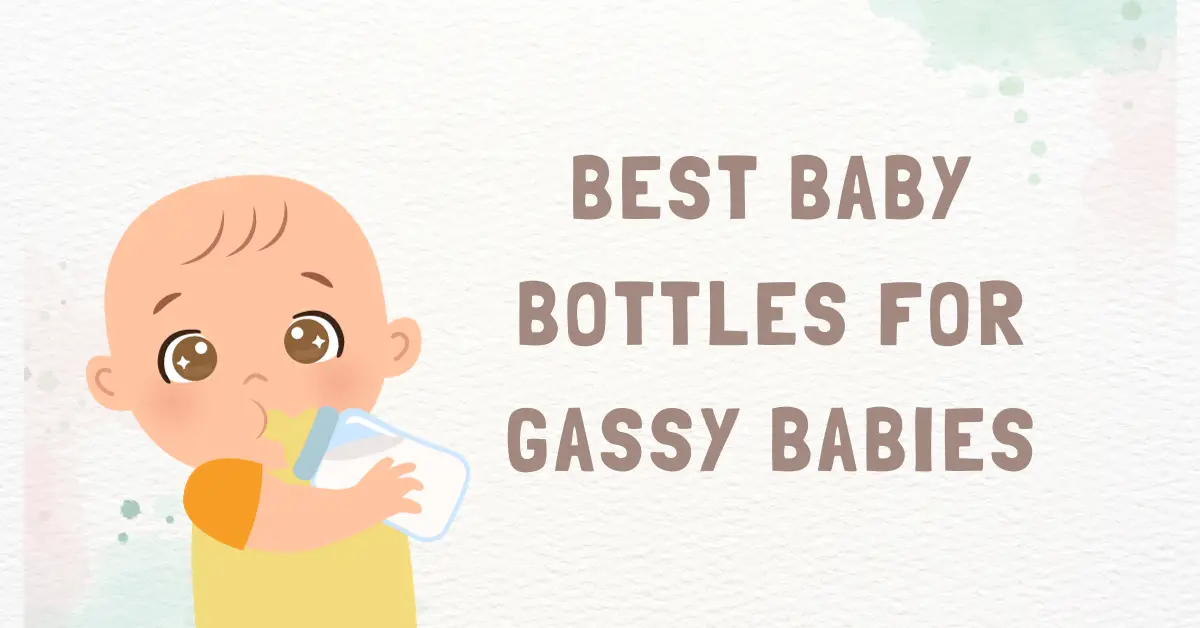Welcoming a new baby into the world is a joyous occasion, but it often comes with challenges. Among them is ensuring that your precious one gets the right nutrition without the discomfort of gas. One common query new parents often grapple with is selecting the best baby bottles for their little one, especially if they’re dealing with a gassy baby. Good news! We’ve got you covered. This article will guide you through picking the best bottles for gassy babies to ensure they get the nourishment they need, minus the distressing gas.
All three of our boys ended up using Dr Brown’s Bottles. They are great bottles overall and we liked the size and shape better than others on the market.
Can Certain Bottles Make Babies Gassy?
Absolutely. The type of bottle you choose plays a pivotal role in how much air your baby might swallow during feeding, which is often the primary cause of gas. Let’s dive deeper into this to understand the dynamics and the connection between the bottle design and a gassy baby.
Bottle Design & Its Role in Gas Formation
Different bottles come in different shapes and designs. However, not all of them can handle the common issue of air bubbles entering a baby’s system. The formation of these gas bubbles in the baby’s tummy can result in discomfort, bloating, and fussiness.
Some bottles allow milk or formula to mix with air, forming air bubbles that the baby swallows. This is where anti-colic bottles come into play. These bottles have specialized anti-colic vents or an internal vent system designed to prevent the mixture of air and milk. By doing so, they minimize the amount of air that babies swallow, making them one of the best bottles for preventing gas.
Air Intake During Feeding
The very act of bottle feeding can lead a baby to swallow more air, especially if the bottle doesn’t have the right features. When babies drink, they can often ingest air, especially if they are sucking rapidly or the flow of milk from the bottle is too fast. This is why choosing a bottle with a slow-flow nipple can be crucial, especially for newborns.
The nipple’s shape also plays a role. Nipples that closely resemble a human nipple or a mother’s breast can reduce the risk of nipple confusion and, more importantly, can lead to a better latch, thereby reducing air intake. A deep latch ensures that the baby’s mouth seals around the nipple, minimizing the chance for air to be sucked in.
Other Factors Contributing to Gas
While the bottle design is a significant factor, it’s essential to recognize that there might be other reasons your baby is gassy. For instance:
- Feeding Technique: The baby’s position during feeding can determine how much air they swallow. An upright position is usually recommended.
- Type of Milk or Formula: Some babies might be sensitive to certain ingredients in formula or even components of breast milk if the breastfeeding mother consumes specific foods.
- Immature Digestive Systems: Babies have developing digestive systems that can be sensitive, making them naturally more prone to gas, irrespective of the bottle used.
In conclusion, while the design and type of bottle are significant contributors to a baby’s gassiness, they aren’t the sole culprits. However, by being informed and choosing the best baby bottles designed to tackle the problem of gas, parents can certainly take a step in the right direction for their baby’s comfort.
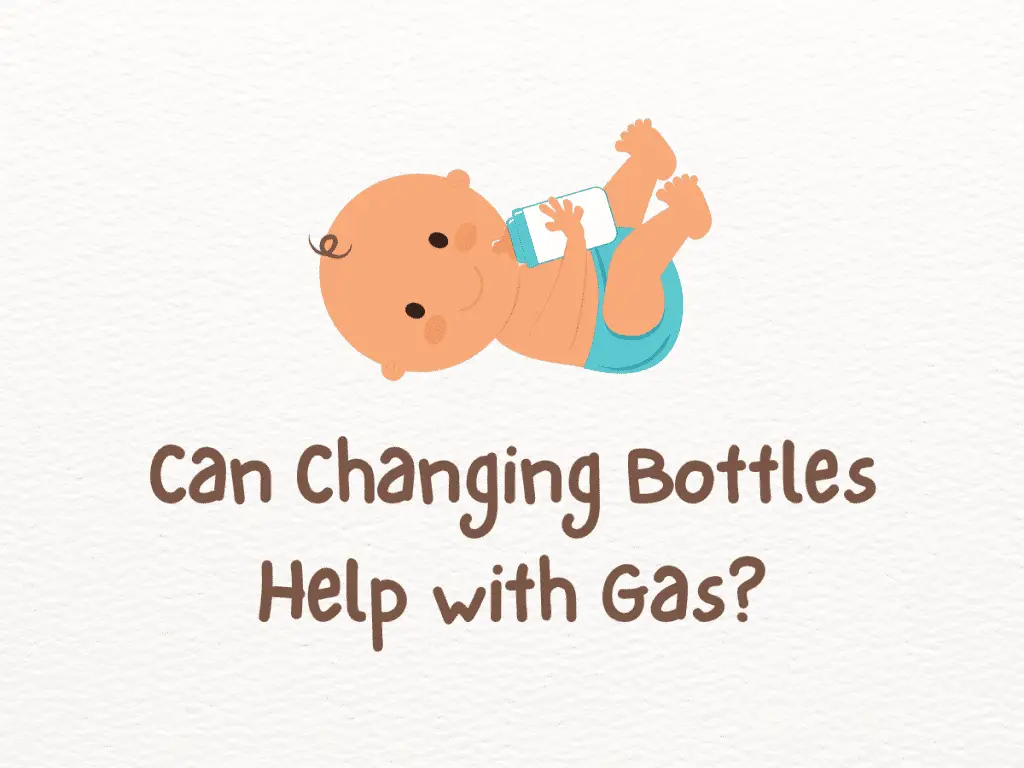
Can Changing Bottles Help with Gas?
Gas discomfort is a frequent concern among new parents. The tell-tale signs of a gassy baby—those tiny clenched fists, the drawn-up knees, and the unmistakable grimace of pain—are hard to miss and harder to ignore. Thankfully, there’s good news: one simple change might make a significant difference. Transitioning to a different bottle could potentially alleviate many of the symptoms your baby may be experiencing.
The Impact of the Right Bottle on Gas
The design of a bottle can influence the amount of air a baby swallows during feeding. Bottles equipped with anti-colic features or an advanced venting system demonstrably reduce the amount of air swallowed. This is largely due to their specialized designs that separate the flow of milk from the air, ensuring the baby drinks less air.
Our Experience
For us as parents of three, switching to Dr. Brown’s bottles with an internal vent system was a game-changer. One of ours was particularly gassy, but once we changed bottles, the difference was night and day.
While every baby is different and there’s no one-size-fits-all solution, changing bottles can often be a step in the right direction. With the combination of scientific evidence and real-world testimonies, it’s clear that the right bottle can make a profound difference in reducing gas and ensuring your baby’s comfort.
What to Look For in a Baby Bottle for Gas
Choosing the right bottle for your little one, especially if they suffer from gas issues, can sometimes feel like navigating a maze. However, armed with the right knowledge, you can ensure that your selection meets all the necessary criteria for maximum comfort. Let’s delve into the key factors to consider when selecting the best bottles to alleviate gas in babies.
Ventilation Systems
One of the top culprits of a gassy baby is the air they swallow during feeding. Modern bottles combat this with advanced venting systems. These systems, such as anti-colic vents or internal vent systems like those in Dr. Brown’s bottles, effectively separate the milk from the air. This ensures that the amount of air your baby swallows is significantly reduced, leading to fewer gas bubbles in the baby’s tummy.
Nipple Design: Mimicking Nature
A well-designed nipple can make a vast difference. Look for a nipple that closely resembles the human nipple or a mother’s breast. This helps in reducing nipple confusion and ensures a better, more natural latch. A good latch means your baby is less likely to swallow air. Additionally, consider the flow rate. A slow-flow nipple can prevent your baby from gulping down milk too quickly, further reducing the chance of swallowing air.
Bottle Shape
The shape of the bottle can influence your baby’s feeding position. Bottles with a wide neck or a slightly angled design can promote a more upright position during feeding. This position is not just ergonomic but also ensures that milk flows down while keeping the air at the top, away from the baby’s mouth.
Material
Bottle material can play a role in the flexibility and the formation of bubbles in the milk.
- Glass Bottles: These are sturdy and don’t degrade over time, ensuring that no microplastics or chemicals leach into the milk.
- Plastic Bottles: Lightweight and durable, but always opt for BPA-free plastic to ensure safety.
- Silicone Bottles: These are gaining popularity due to their softness and flexibility. Silicone bottles, like the Comotomo baby bottle, are designed to mimic the natural feel of a mother’s breast, thereby reducing nipple confusion and ensuring better milk flow without bubble formation.
Ease of Cleaning
A bottle with numerous small parts might be harder to clean thoroughly. Leftover milk residues can breed bacteria, which can exacerbate gas issues when consumed by the baby. Therefore, a bottle with a simple design, preferably with a wide-neck design, is not just easier to clean but also more hygienic. Investing in a good bottle brush can also ensure every nook and corner is cleaned, leaving no scope for bacteria to thrive.
While all babies are unique, focusing on these key features can guide new parents in their quest to find the best baby bottles for their gassy little ones. A bottle that checks these boxes will not only provide comfort but also a pleasant feeding experience for both baby and parent.
Top Recommendations for Best Bottles for Gassy Babies
Selecting the perfect bottle for your gassy baby doesn’t have to be a daunting task. Based on extensive research and feedback from parents, we’ve curated a list of top bottles that stand out in the market. Here’s a closer look at each, complete with their standout features, pros, and cons.
1. Dr. Brown’s Bottles
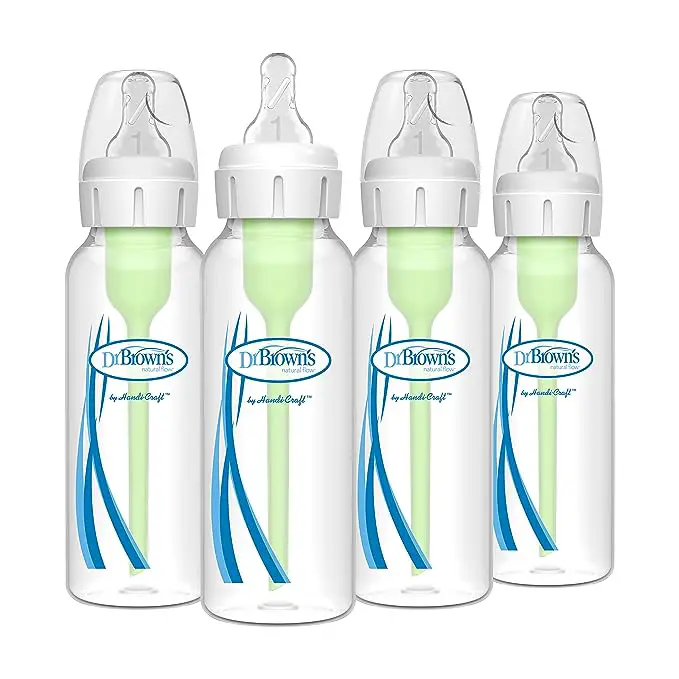
We ended up using Dr Brown’s Bottles for all 3 of our boys. They lasted a long time, took quite the beating, and still worked great. The Dr Browns line has plenty of easily replaceable parts if anything breaks or stops working which helps extend the life of the bottles. They also have a wide variety of bottles from small newborn size to the ones pictured above and even glass bottles if you would prefer them.
Features:
- Internal vent system for reduced air intake
- BPA-free plastic
- Available in both standard and wide-neck design
Pros:
- Clinically proven to reduce colic symptoms
- Mimics a steady flow similar to breastfeeding
Cons:
- Multiple parts can make cleaning a bit tedious
See Dr Brown’s Bottles on Amazon.
2. Comotomo Baby Bottles
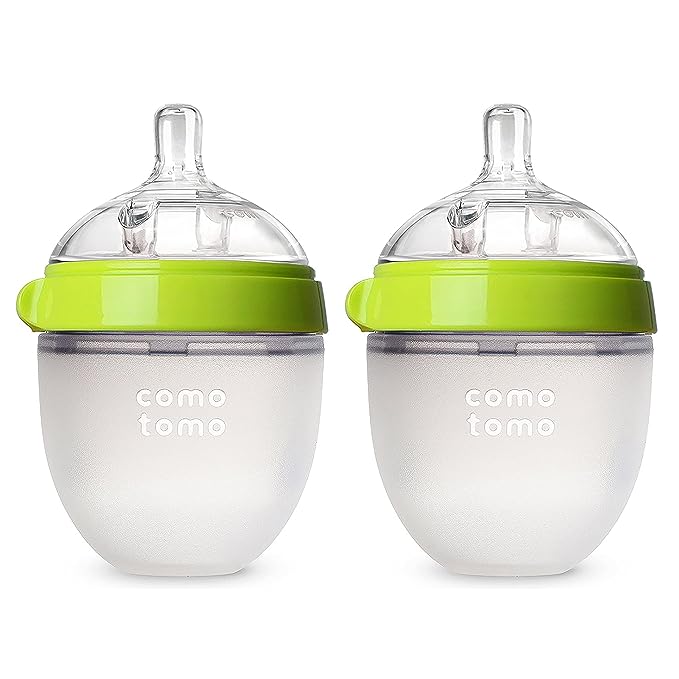
Comotomo bottles have innovated on traditional baby bottle design with the most unique bottles on the market today. The ultra-wide neck allows for much easier cleaning. You can get around this with bottle brushes for narrow neck bottles but the wide neck really does make a big difference for cleaning. The bottles are also made from soft silicone which both improves durability but can also make for an unstable bottle.
Features:
- Soft, squeezable silicone bottle that mimics natural breastfeeding
- Dual anti-colic vents
- Wide neck for easy cleaning
Pros:
- Extremely baby-friendly, reducing chances of nipple confusion
- Simple design makes it easy to clean
Cons:
- Some parents find the silicone material a bit too flexible
Check out the Comotomo bottles on Amazon.
3. Tommee Tippee Closer to Nature Bottles
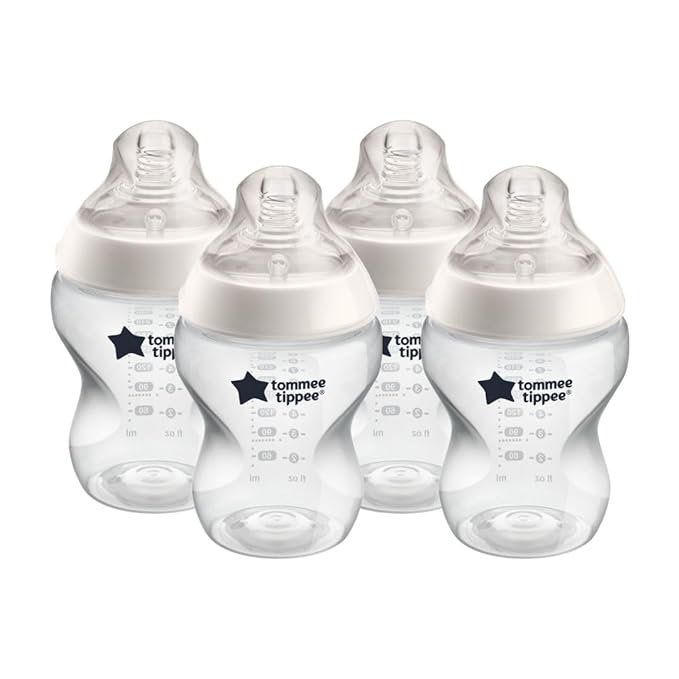
Tommee Tippee’s bottles feature a wide-neck opening for easier cleaning and an easy-to-hold design. These bottles are the nicest to hold of the bottles reviewed here. Less parts also make them quicker to clean but otherwise, they don’t feature much to help with gassy babies. We like the valve and stem design of Dr. Brown’s bottles to the anti-colic valve found on the Tommee Tippee bottles.
Features:
- Breast-like nipple shape for a natural latch
- Anti-colic valve to reduce air ingestion
- BPA-free plastic
Pros:
- Designed to mimic the mother’s breast, aiding in a smooth transition between breast and bottle-feeding
- Easy to hold for parents and babies
- Wide neck for easier cleaning
Cons:
- Nipples have a tendency to collapse into the bottle
Check out Tommee Tippee Closer to Nature Bottles on Amazon.
4. Philips Avent Natural Baby Bottle
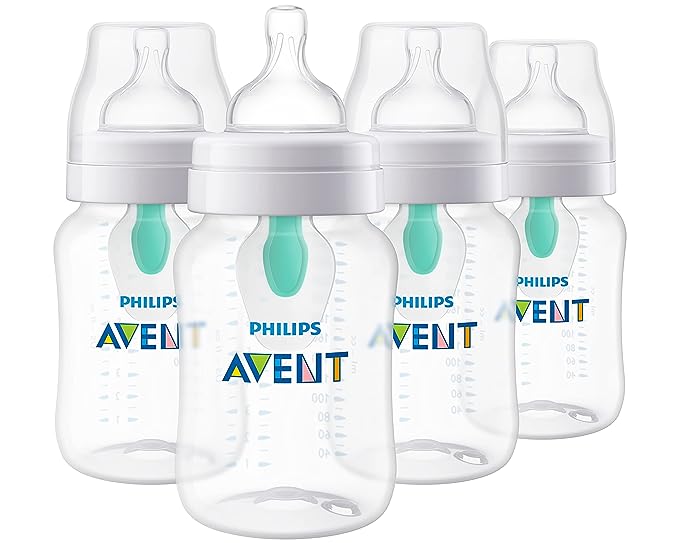
The Philips Avent bottles are a bit of a middle ground between all of the other bottle types. They feature a slightly wider neck, an air-free vent similar to the Dr Brown’s bottles, and a slight contour to make them easier to grip. They are good all-around bottles but we also didn’t find the best at anything either. But you certainly can’t go wrong with the Philips Avent bottles either.
Features:
- Wide, breast-shaped soft silicone nipple
- Advanced anti-colic air valve
- Comes in both 5-ounce and 8-ounce sizes
Pros:
- Easy to assemble and clean due to fewer parts
- Wide neck makes filling and cleaning straightforward
Cons:
- Some parents reported occasional leaks
Check out Philips Avent Bottles
5. MAM Easy Start Anti-Colic Bottle
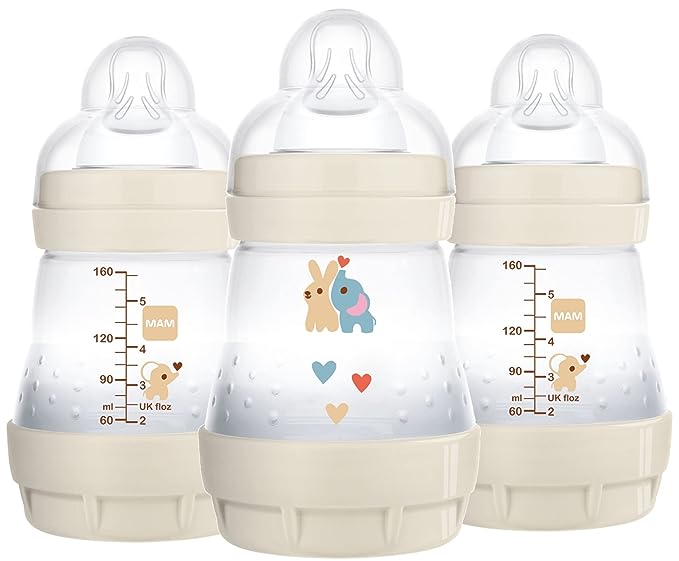
Perhaps the most unique baby bottles on the market today are the MAM Easy Start Anti-Colic Bottles. The reason for the unique design is that the bottles are self-sterilizing with a little bit of water in the bottom of the bottle base and placed in the microwave for 3 minutes.
Features:
- Patented vented base ensures even milk flow without bubbles
- Self-sterilizing design
- Silicone nipple with a skin-soft texture
Pros:
- Reduces gas and reflux significantly
- The self-sterilizing feature is a big plus for on-the-go parents
Cons:
- The multiple parts might require a bit of time to get used to during assembly
Check out the MAM bottles on Amazon.
In your search for the best baby bottles for gassy babies, any of these options are likely to bring relief and comfort to your little one. While all babies are unique and might react differently, these bottles have been lauded for their design and functionality, making them top picks for parents navigating the challenges of gas and colic.
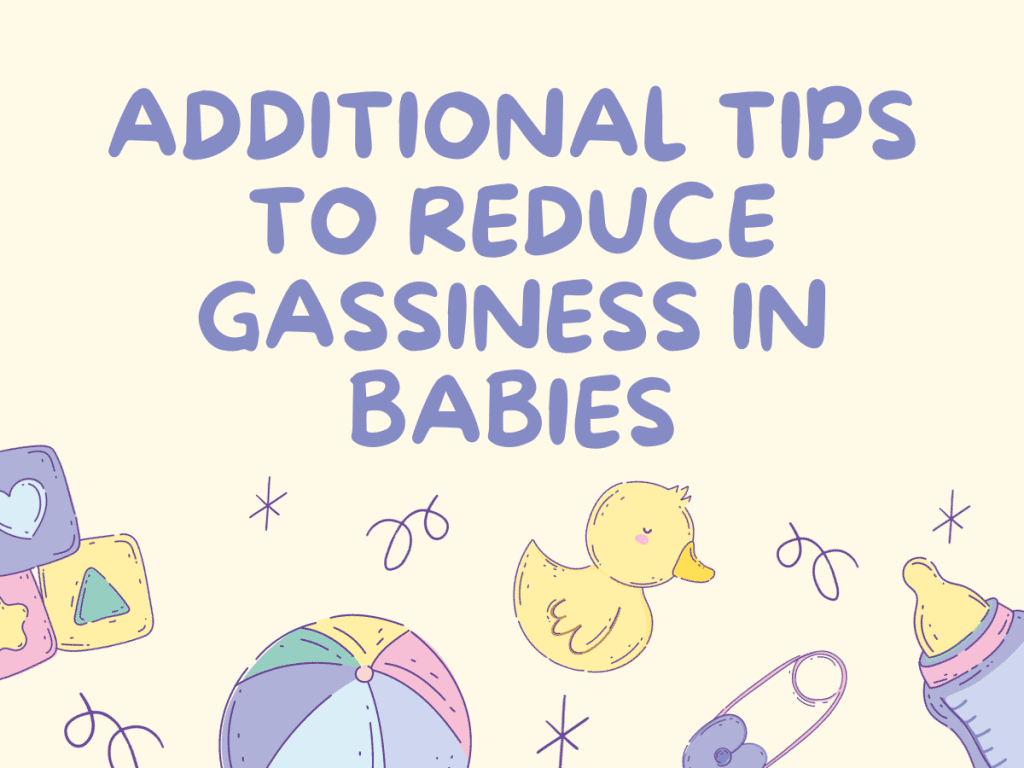
Additional Tips to Reduce Gassiness in Babies
While selecting the right bottle is a crucial step in alleviating your baby’s gas issues, there are additional practices that can further optimize your little one’s comfort. Let’s explore some tried-and-tested techniques to keep those pesky gas bubbles at bay.
1. Proper Feeding Techniques: Position Matters
Ensuring that your baby is in the right position during feeding can make a significant difference in reducing air intake. An upright position is usually recommended. This position ensures that the milk flows to the bottom of the bottle, while the air remains at the top, thus reducing the chances of your baby swallowing air bubbles. Also, make sure the bottle nipple is entirely filled with milk or formula to prevent air gulping.
2. The Magic of Burping: Release the Air
Burping is a simple yet effective way to release any trapped air that your baby might have swallowed. It’s a good idea to burp your baby both during and after feeds. This practice can be especially useful if you notice your baby is particularly gassy or if they tend to eat quickly. Remember, every baby is different; some might need to be burped more frequently than others.
3. Diet Adjustments: What Goes In Matters
If your baby is on formula, it’s worth noting that some brands or types might be more gas-inducing than others. For breastfed babies, the mother’s diet can also play a role. Some foods in a breastfeeding mother’s diet can cause gas in babies. Common culprits include dairy, caffeine, and certain vegetables like broccoli or cabbage. If you suspect a particular food might be causing the issue, you can try eliminating it from your diet for a week or two to see if it makes a difference.
4. Paced Bottle Feeding: Slow and Steady
Paced bottle feeding is a technique where you control the flow of milk, ensuring your baby doesn’t drink too quickly. By holding the bottle horizontally and allowing your baby to suck and swallow at their own pace, you can reduce the amount of air they swallow. This method closely mimics breastfeeding, allowing the baby to take breaks and reducing the risk of overeating and swallowing excess air.
In conclusion, while the right bottle is essential, these additional techniques can further ensure that your baby has a comfortable feeding experience free from gas discomforts. Every baby is unique, so it might require some trial and error to find out what combination of methods works best for your little one. But with patience and observation, a happier, less gassy baby is well within reach.
Frequently Asked Questions
Gas issues are a common concern for many new parents, leading to a myriad of questions. Here, we address some of the most frequently asked queries to provide clarity and peace of mind.
Q: How do I know if my baby is gassy?
A: Babies have their own unique ways of communicating discomfort, and gassiness is no exception. Common signs of a gassy baby include a bloated stomach, frequent crying, especially after feeding, clenching of the fists, pulling the legs up towards the baby’s tummy, and passing gas more than usual. Additionally, if your baby seems restless or doesn’t settle easily post-feeding, it might be due to gas discomfort.
Q: Are there other products besides bottles that can help reduce gassiness?
A: Absolutely! While the right bottle plays a significant role, other products can assist in reducing gas. Gas drops or over-the-counter baby gas relief medicines can sometimes be beneficial. Additionally, baby gripe water, a blend of water and various herbs, is popular among some parents as a natural remedy. Probiotic drops can also help balance the baby’s gut flora, potentially reducing gas. Always remember to consult with a pediatrician before introducing any new product or medicine to ensure it’s safe and appropriate for your little one.
Q: How often should I replace baby bottles?
A: The lifespan of a baby bottle largely depends on its material and frequency of use. As a general rule, plastic bottles should be replaced every few months if they are used regularly. Signs that it’s time for a replacement include discoloration, warping, or any signs of damage. Silicone bottles and glass bottles tend to last longer but should be replaced if you notice cracks or cloudiness. Regardless of the material, the bottle’s nipples should be checked frequently for signs of wear and replaced every 1-2 months or at the first sign of damage.
Having the right knowledge and tools can significantly ease the journey of new parents. Remember, it’s always a good idea to consult with your pediatrician or lactation consultant if you have concerns or need guidance tailored to your baby’s specific needs.
Wrapping Up The Best Bottles For Gassy Babies
Navigating the early stages of parenthood, especially when faced with challenges like a gassy baby, can be daunting. However, equipped with the right knowledge, tools, and resources, parents can make informed decisions to ensure their baby’s comfort and well-being. By selecting the appropriate bottle, adopting suitable feeding techniques, and staying informed, parents can alleviate many of the common discomforts babies face. Remember, every baby is unique; what works for one might not for another. It’s always about finding the right balance and solution tailored to your little one’s needs. As always, never hesitate to seek guidance from professionals when in doubt, and trust in your parental instincts. After all, your love and commitment to your baby’s well-being are the most vital ingredients in this beautiful journey.

